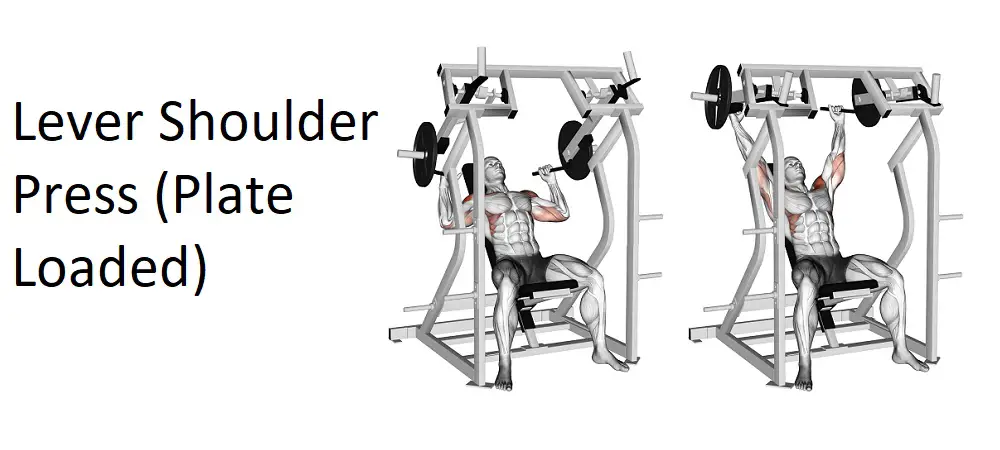Table of Contents
Introduction
The Lever Shoulder Press (Plate Loaded) is a machine-based exercise that focuses on developing the shoulder muscles through a safe and controlled pressing movement. Unlike free weights, which require more stabilization and can be tricky for beginners, the Lever Shoulder Press provides a fixed path of motion, reducing the risk of injury while still offering significant strength and muscle-building benefits. It is particularly effective for targeting the deltoid muscles while engaging secondary muscles like the triceps and upper chest.
This machine exercise is a popular choice for both beginner and advanced lifters because it allows for easy adjustments in resistance using plates and ensures that the movement remains stable throughout. Whether you’re looking to build shoulder size, improve strength, or tone the upper body, the Lever Shoulder Press is a staple exercise in any fitness regimen.
Instructions: How to Perform Lever Shoulder Press (Plate Loaded)
To properly execute the Lever Shoulder Press, follow these steps:
- Adjust the Seat: Ensure that the seat height is set so that the handles are at shoulder level. This allows for an optimal range of motion, targeting the shoulders effectively.
- Positioning: Sit down on the machine with your back firmly pressed against the backrest. Your feet should be flat on the floor for stability, and your back should remain in a neutral position throughout the movement to avoid any strain on the lower back.
- Grip: Grab the machine’s handles using an overhand grip (palms facing forward). Your hands should be positioned slightly wider than shoulder-width apart to ensure full engagement of the deltoids.
- Starting Position: Begin with the handles just below or at shoulder height, your elbows bent, and your core engaged. This is your starting point for the press.
- Pressing Motion: Press the handles upward in a controlled manner, extending your arms fully without locking your elbows at the top. Focus on contracting your shoulder muscles during the movement.
- Lowering the Weight: Slowly lower the handles back to the starting position, maintaining control throughout the descent. Avoid letting the weight drop too quickly, as this could lead to injury or a decrease in muscle engagement.
- Repetitions: Aim for 3–4 sets of 8–12 repetitions for hypertrophy (muscle growth) or 12–15 reps for endurance. Beginners should start with lighter weights to master the technique before increasing the load.
Pro Tips:
- Keep your core engaged throughout the entire movement to protect your lower back.
- Avoid flaring your elbows too far outward, as this can place excessive stress on your shoulder joints.
- Always control the weight during both the pressing and lowering phases for maximum muscle activation.
Benefits of Lever Shoulder Press (Plate Loaded)
The Lever Shoulder Press offers several unique advantages over traditional free-weight shoulder presses. Here’s why it’s a valuable addition to any upper-body workout routine:
- Improved Stability: The machine’s fixed movement pattern provides stability, making it easier to maintain proper form compared to free weights. This is especially beneficial for beginners or those recovering from injuries.
- Targeted Shoulder Engagement: The Lever Shoulder Press isolates the shoulder muscles, particularly the deltoids, allowing for maximum activation without the need for stabilization from other muscle groups.
- Safety: Since the machine supports your back and guides the movement, it reduces the risk of injury, especially for those who are unfamiliar with overhead pressing movements. There is less risk of losing balance or control.
- Progressive Overload: The plate-loaded design makes it easy to progressively increase resistance as you become stronger. This ability to adjust the load quickly is great for both strength and hypertrophy training.
- Balanced Muscle Development: The symmetrical design of the machine ensures both sides of your body are working equally, helping to correct muscular imbalances that can occur with free-weight exercises.
- Time-Efficient: The machine setup and weight adjustment are quick and easy, making it a time-efficient option for busy gym-goers who want to target their shoulders without spending time setting up free weights.
Muscles Worked in Lever Shoulder Press (Plate Loaded)
The Lever Shoulder Press mainly targets the shoulder muscles, but several other muscle groups are involved in the movement. Here’s a breakdown:
- Deltoid Muscles:
- Anterior Deltoid (Front Shoulder): This muscle is the primary mover during the pressing motion, responsible for shoulder flexion.
- Lateral Deltoid (Side Shoulder): The lateral head of the deltoid provides stability and assists in the pressing movement, contributing to the development of shoulder width.
- Posterior Deltoid (Rear Shoulder): Though less engaged than the front and side delts, the posterior deltoid stabilizes the shoulder joint during the exercise.
- Triceps Brachii: The triceps assist in the extension of the elbows during the pressing phase, playing a supporting role in the overall movement.
- Upper Pectoralis Major (Upper Chest): The upper portion of the chest is also engaged during the press, particularly at the bottom of the movement when you initiate the upward push.
- Trapezius and Serratus Anterior: These muscles help stabilize the shoulder blades and upper back, ensuring proper alignment during the pressing movement.
By targeting multiple muscle groups, the Lever Shoulder Press provides a comprehensive upper-body workout, particularly focused on building shoulder strength and size.
Video: How to Do Lever Shoulder Press (Plate Loaded)
Other Names for Lever Shoulder Press (Plate Loaded)
The Lever Shoulder Press may be referred to by different names depending on the gym or manufacturer of the equipment. Here are a few alternative names:
- Plate-Loaded Overhead Press
- Plate-Loaded Machine Shoulder Press
- Machine Overhead Press
- Lever Military Press (when performed in a seated upright position)
Despite the variation in names, the movement and benefits remain largely the same.
FAQs
1. Is the Lever Shoulder Press good for beginners?
Yes, the Lever Shoulder Press is an excellent exercise for beginners. Its fixed path of motion and back support make it easier to maintain proper form and reduce the risk of injury compared to free-weight presses.
2. How does the Lever Shoulder Press compare to dumbbell or barbell presses?
The Lever Shoulder Press offers more stability and safety than free-weight versions. While dumbbell and barbell presses require stabilizer muscles and offer a more functional movement, the machine press allows for better isolation of the shoulder muscles, making it ideal for muscle growth.
3. How much weight should I lift on the Lever Shoulder Press?
The weight you choose should allow you to perform 8–12 repetitions with proper form. Start light, especially if you’re new to the exercise, and gradually increase the load as you become more comfortable with the movement.
4. Can I use the Lever Shoulder Press if I have a shoulder injury?
If you have a shoulder injury, it’s best to consult with a healthcare professional before performing this exercise. While the machine offers more support than free weights, any overhead pressing motion can still place stress on the shoulder joint.
5. How often should I do the Lever Shoulder Press?
Incorporate the Lever Shoulder Press into your shoulder or upper-body workout routine 1–2 times per week, allowing for adequate recovery between sessions. Overtraining the shoulders without proper rest can lead to injury.
Conclusion
The Lever Shoulder Press (Plate Loaded) is a powerful exercise for building shoulder strength and size in a safe, controlled environment. Its design allows for a fixed range of motion, minimizing the risk of injury while maximizing shoulder engagement. Whether you’re a beginner looking to build foundational strength or an advanced lifter aiming to isolate and sculpt the shoulders, the Lever Shoulder Press is a must-have in your workout routine. By incorporating this machine-based press into your training, you’ll develop strong, well-rounded shoulders that not only enhance your physique but also improve your overall upper-body strength.
Other Shoulder Exercises
- Lever Reclined Shoulder Press (Plate Loaded)
- Lever Military Press (Plate Loaded)
- Cable Seated Shoulder Press
Also, read Shoulder press exercise machine and method of exercising








